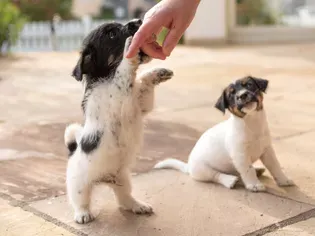How to Train Your Dog to Have Bite Inhibition
Updated on 04/26/24

Mastering the Art of Bite Inhibition: A Comprehensive Guide to Training Your Dog
In the realm of dog ownership, bite inhibition is a crucial concept that fosters a harmonious coexistence between humans and their canine companions. It refers to a dog's ability to restrain their bite force, even in playful or excited situations. Dogs with good bite inhibition are less likely to cause harm, making them safer and more enjoyable pets.
While every dog has the potential to bite, it's essential to recognize that biting is a natural behavior for them. Dogs use their mouths to explore their surroundings, interact with other animals, and defend themselves. However, it's our responsibility as responsible owners to teach them the appropriate and safe use of their teeth.
This comprehensive guide will delve into the intricacies of bite inhibition training, providing you with step-by-step instructions, real-world examples, and expert advice to help you achieve your goal.
Understanding Bite Inhibition
Before embarking on the training process, it's important to understand the underlying principles of bite inhibition.
* Innate Inhibition: Puppies are born with a natural level of bite inhibition, which they learn from their interactions with their littermates. By playfully biting each other, they develop an understanding of how hard they can bite without causing pain.
* Socialization: As puppies grow and interact with different people and animals, they learn to adjust their bite force accordingly. Positive experiences help them understand that biting humans is not acceptable.
* Training: While dogs have an innate ability to learn bite inhibition, formal training can help reinforce and strengthen this behavior.
Training Methods
To effectively train your dog to have bite inhibition, a combination of positive reinforcement, negative reinforcement, and redirection is necessary.
Positive Reinforcement:
* Reward Calm Behavior: Reward your dog with treats, praise, or play when they exhibit calm and gentle behavior. This teaches them that non-biting is the desired behavior.
* Play Games: Engage in games like tug-of-war, where your dog learns to control their bite force while pulling on the toy. Always end the game if they bite too hard.
Negative Reinforcement:
* "Ouch" Method: When your dog bites you, immediately say "ouch" in a high-pitched voice. This simulates the sound of a puppy yelping in pain, which naturally causes them to pause and release their bite.
* Time-Outs: If your dog continues to bite too hard despite the "ouch" method, place them in a designated time-out area for a few minutes. This teaches them that biting leads to undesirable consequences.
Redirection:
* Offer Toys: Keep plenty of chew toys and safe items on hand for your dog to redirect their urge to bite. This provides them with an alternative outlet for their chewing needs.
* Establish Boundaries: Clearly define areas where biting is not allowed, such as furniture or people's hands. If your dog bites in these areas, redirect them to an appropriate place.
Example Training Scenarios:
* Playtime Biting: When your dog bites too hard during playtime, say "ouch" and gently disengage. Redirect them to a chew toy and praise them for playing appropriately.
* Excitement Biting: If your dog becomes overexcited and starts biting, calmly say "ouch" and step away from them. Wait until they calm down before re-engaging with them.
* Fear Biting: If your dog is biting out of fear, approach the situation cautiously. Avoid punishing them, as this could worsen the behavior. Instead, seek professional help from a veterinarian or certified dog trainer.
Additional Tips:
* Start Training Early: Begin bite inhibition training as soon as your puppy comes home. This will help them develop healthy habits from the start.
* Be Consistent: Maintain consistency in your training methods to prevent confusion.
* Reward Consistency: Always reward your dog for good behavior, even if it's just a small improvement.
* Avoid Punishing: Physical punishment or harsh scolding can damage your bond with your dog and make training less effective.
* Consult a Professional: If you encounter any difficulties or have concerns about your dog's bite inhibition, don't hesitate to consult with a veterinarian or certified dog trainer.
Conclusion:
Training your dog to have bite inhibition is a rewarding endeavor that promotes harmony and safety in your relationship. By implementing the techniques outlined in this comprehensive guide, you can help your canine companion develop a strong understanding of appropriate biting behaviors. Remember, patience, consistency, and positive reinforcement are key to successful training. With dedication and a compassionate approach, you can foster a mutually enjoyable and fulfilling bond with your beloved dog.
Explore More Pets

Basic Training
Puppy and Baby Introductions

Working Dog Breeds
All About Search and Rescue Dogs

Dog Treatments
Puppy Vaginitis: Signs, Causes and Treatment

Dog Adoption
After More Than 1,200 Days in the Shelter, Coco Goes Home

Basic Training
How to Train Your Puppy to Go on Potty Pads

Hybrid Dog Breeds
The Difference Between a Mutt, Mixed Breed, or Designer Dog?

Dog Treatments
Nail Problems in Dogs

Puppies
7 Reasons Why Two Dogs Are Better Than One